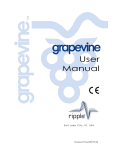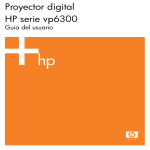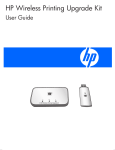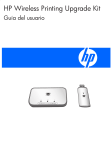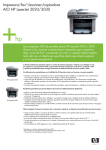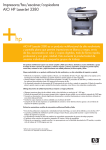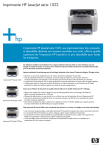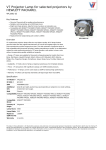Download HP pn1050 Setup Guide
Transcript
HP Jetdirect pn1050 Network Projector Manager Setup Guide © Copyright 2005 Hewlett-Packard Development Company, L.P. Reproduction, adaptation, or translation without prior written permission is prohibited, except as allowed under the copyright laws. The information contained in this document is subject to change without notice. The only warranties for HP products and services are set forth in the express warranty statements accompanying such products and services. Nothing herein should be construed as constituting an additional warranty. HP shall not be liable for technical or editorial errors or omissions contained herein. Edition 1, 8/2005 Trademark Credits Microsoft®, MS-DOS®, Windows®, are U.S. registered trademarks of Microsoft Corporation. NetWare® and Novell® are registered trademarks of Novell Corporation. Ethernet is a registered trademark of Xerox Corporation. PostScript is a trademark of Adobe Systems, Incorporated. UNIX® is a registered trademark of the Open Group. Table of Contents 1. Introducing the HP Jetdirect Network Projector Manager System Overview ................................................................................. 4 2. Installing the HP Jetdirect Module What’s in the Box?............................................................................... 5 Setting Up the Module ......................................................................... 6 Connecting the Module .................................................................... 6 Mounting the Module (Optional) ..................................................... 8 Finding the Network Address ........................................................ 10 3. Managing HP Projectors Configuring the Module and Projector .............................................. 11 Using a Web Browser ........................................................................ 11 Using Web Jetadmin .......................................................................... 12 4. Fixing Problems Troubleshooting ................................................................................. 13 Indicator Lights .................................................................................. 14 Testing the System ............................................................................. 15 Resetting to Factory Defaults............................................................. 16 5. Reference Information Specifications ..................................................................................... 17 Regulatory Information...................................................................... 18 U.S.A.............................................................................................. 18 Australia ......................................................................................... 19 Canada............................................................................................ 19 Japan............................................................................................... 19 Korea .............................................................................................. 19 Taiwan............................................................................................ 19 China .............................................................................................. 20 International ................................................................................... 21 3 1 Introducing the HP Jetdirect Network Projector Manager System Overview The Jetdirect network projector manager is a network server module that connects to the USB port of a Jetdirect-compatible HP digital projector to provide network access to that projector. This enables a system administrator to monitor and manage this and any other connected projectors from a remote location. The administrator can use a standard Web browser to manage individual projectors, or use free HP Web Jetadmin software to manage many projectors. The network projector manager includes a USB 2.0 port, and is compatible with the following networks and projectors: ● Ethernet (IEEE 802.3i 10Base-T) and Fast Ethernet (IEEE 802.3u 100Base-TX) networks. See “Specifications” on page 17 for details about supported network protocols. ● HP vp6300 series digital projectors (firmware version 2.000 or later), and newer models of non-mobile HP business projectors. For a list of compatible projectors, go to www.hp.com/support and look up your Jetdirect model number. 4 2 Installing the HP Jetdirect Module What’s in the Box? Before setting up the module and projector, make sure your shipping box includes the following items. If any of these items were not in the box, contact HP — see the support guide on the Documentation CD. ■ server module ■ power module ■ USB cable ■ mounting strips (two) ■ documentation CD ■ Quick Setup Guide 5 Setting Up the Module Connecting the Module 1. Make sure the projector is set up and operating normally. 2. Plug a LAN cable into the server module. The LAN cable must be connected to a 10Base-T or 100Base-TX Ethernet local area network. 3. Plug the USB cable into the server module and the projector. The wide connector plugs into the module, and the narrow connector plugs into the projector. Note Do not connect the USB cable to any USB hub, converter, or extender. Installing the HP Jetdirect Module 6 4. Plug the power cable from the power module into the server module, then plug the power module into a power outlet. 5. Check the indicator lights on the server module: ■ The power/status light (2) on top of the server module should light solid green within 15 seconds to show proper startup. Then it may flicker irregularly to show network communication. ■ One of the LAN connector lights (3) should turn on to show the network connection speed. ■ The USB/projector light (1) on top of the server module should light solid green to show a good USB connection. If any of these does not occur, see “Indicator Lights” on page 14. Installing the HP Jetdirect Module 7 Mounting the Module (Optional) You can mount the server module on the projector or on any nearby smooth, clean surface. The attachment strips separate to allow you to remove the module temporarily. 1. Decide where to mount the server module on the projector or other surface: ■ Make sure the mounting surface is flat, smooth, and clean. ■ Do not block any vents, controls, or access panels on the projector. ■ Make sure the cables from the module do not interfere with controls or access panels on the projector. 2. Peel the backing paper off one side of an attachment strip. Note Do not separate the two halves of the strip. 3. Attach the strip along the top or bottom edge of the label on the bottom of the server module. Press firmly to get full adhesion. Note Do not cover the module’s serial number. 4. Attach the other strip to the opposite edge of the label as described above. 5. Clean the projector or other surface where you intend to mount the module. Installing the HP Jetdirect Module 8 6. Peel the backing paper from the exposed sides of the two attachment strips. 7. Press the module firmly onto the mounting surface so that the attachment strips adhere properly. To remove the module, gently pull it away from its mounting surface so that the halves of the attachment strips separate. To reattach the module, press it back into place so that the strips reattach. Note As an alternative, you can mount the module to a wall or other solid surface using the two keyhole slots in the bottom of the module. Insert two screws into the surface 33 mm (1–5/16 in) apart, then slide the keyhole slots over the heads of the screws. Installing the HP Jetdirect Module 9 Finding the Network Address Use the HP projector’s on-screen menu to find the network address assigned to the server module and projector: 1. Turn on the projector. 2. Open the on-screen menu by pressing the enter or menu button on the projector or its remote control. 3. Go to the Help screen and find the IP address, which consists of four numbers separated by dots, such as 10.2.3.4. Installing the HP Jetdirect Module 10 3 Managing HP Projectors Configuring the Module and Projector You can use the server module to configure and monitor the projector from a remote location on the network. Using your computer, you can perform tasks such as these: ● Configure the server module’s network settings. ● Receive email notifications when certain conditions or events occur on the projector. ● Set security options to require passwords, encrypt data, and control access. ● Upgrade the firmware on the projector and server module. For complete information about managing projectors, see the Administrator’s Guide on the Documentation CD. Using a Web Browser Each projector server module contains an embedded Web server, which acts as a Web site from which you can remotely configure various settings on the the server module and projector and check their status. 1. On the projector, open the on-screen menu, go to the Help menu, and note the IP address shown on the main menu screen. The address consists of four numbers separated by dots, such as 10.2.3.4. 2. On a networked computer, open an internet browser, enter the IP address of the projector in the URL bar (for example, type 10.2.3.4 or http://10.2.3.4), and press the Enter key. 11 3. Go to the location in the Web interface that contains the information you need or the setting you want to change. 4. Make any necessary changes, then click Apply. For more information about the embedded Web server, click Help in the Web interface. See the Administrator's Guide on the Documentation CD for complete details. Using Web Jetadmin HP Web Jetadmin is a simple peripheral-management application for remotely installing, configuring, and managing a wide variety of HP and non-HP printers and HP projectors through a standard Web browser. You can use Web Jetadmin to proactively solve problems before they affect user productivity. You can download this software for free at www.hp.com/go/webjetadmin. Web Jetadmin supports the management of Jetdirect-compatible HP projectors. Support for projectors requires HP Web Jetadmin version 7.8 or greater, along with the HP Web Jetadmin application plug-in for digital projectors. We recommend using the latest version, which may provide enhanced functionality. Web Jetadmin provides access to all the functions of the embedded Web server — and it supports many operations on groups of projectors. For complete information, go to www.hp.com/go/webjetadmin. Managing HP Projectors 12 4 Fixing Problems Troubleshooting If you have trouble with your server module or network connection, check the information in this chapter. Note If you have trouble with projector operation, see the projector user manual. 1. Make sure the projector is connected to power and is operating properly. See the projector user manual if the projector has any problems. 2. Make sure the server module is connected to power, to a local-area network (LAN), and to the projector. 3. Check the indicator lights on top of the server module: ■ If the power/status light is flickering irregularly and the USB/projector light is solid green, the setup is good. ■ Any other light condition indicates a possible problem. See “Indicator Lights” on page 14. 4. On the projector, open the on-screen menu, go to the Help menu, and check the IP address shown on the screen. The address consists of four numbers separated by dots, such as 10.2.3.4. ■ If the IP address is shown, the connection between the module and projector is good. Note the IP address for the next step. ■ If no IP address is shown, the USB communication is bad. Check the USB cable. Check for Jetdirect compatibility in the specifications for the projector model and firmware version — or go to www.hp.com/support and look up the model number of your Jetdirect server. 13 5. On a networked computer, open an internet browser, enter the projector’s IP address in the URL bar, and press the Enter key. ■ If the projector information page appears, the network connection is working. ■ If the projector information page does not appear, network communication is bad. Check the LAN cable. Check the network with a different device. Connect the module to a different LAN outlet. For further assistance, see the Administrator's Guide. If you are not able to fix the problem using these steps and the Administrator’s Guide, contact HP for assistance. See the support guide on the documentation CD or go to www.hp.com/support. Indicator Lights The indicator lights on the server module provide important information about the module’s status. Power/Status Light Off Not receiving power. ● Check the power module and power source. On steady (green) On and ready, but no network communication. ● Check the LAN 10/100 lights. Flickering irregularly (green) Normal: on and receiving network communication. Blinking (green) Module is starting up (up to 15 seconds after applying power), or no network connection is detected. ● Check the LAN 10/100 lights. Blinking (orange) Problem detected during startup. Unplug, then reconnect power. If the condition persists, contact HP. ● LAN 10/100 Lights Both off No network connection. ● Check the LAN cable. Check the network with a different device. Connect the module to a different LAN outlet. ● On steady (green) See the Administrator’s Guide. Normal: USB is ready. Fixing Problems 14 USB/Projector Light Off Module is starting up (up to 15 seconds after applying power), or a USB problem is detected. ● Make sure a USB cable connects to a projector, and the projector is connected to power. ● Try a different USB cable. ● Unplug, then reconnect power. If the condition persists, the module or projector is faulty. If possible, repeat with a different module or projector. On steady (green) Normal: USB is ready. Blinking (green) USB device is not compatible with the server module. ● Check for Jetdirect compatibility in the specifications for the projector model and firmware version — or go to www.hp.com/support and look up the model number of your Jetdirect server. Not all HP projectors with a USB connector support the connection of a Jetdirect module. Blinking (orange) Hardware problem. ● Unplug the USB cable from the module, then unplug and reconnect power. Then reconnect the USB cable. If the condition persists, continue with the following steps. ● Unplug the USB cable at both ends, then unplug and reconnect power. If the condition persists, the server module is faulty. ● Plug the USB cable only into the module, then unplug and reconnect power. If the condition persists, the cable is faulty. ● Plug the USB cable into the module and projector, then unplug and reconnect power. If the condition persists, the projector is faulty. Testing the System 1. Make sure the projector is connected to power, and that the server module is connected to the LAN and to the projector. 2. Unplug and reconnect power to the server module. 3. Wait at least 15 seconds, then check the indicator lights on the module: ■ If the power/status light is flickering irregularly and the USB/projector light is solid green, the setup is good. ■ Any other light condition indicates a possible problem. See “Indicator Lights” on page 14. Fixing Problems 15 Resetting to Factory Defaults The server module retains its configuration settings in memory, even while power is removed. You can reset all configuration settings to the default factory settings as follows. 1. Unplug the power module from the server module. 2. Press and hold the Reset button next to the LAN port on the back of the server module. 3. While holding the Reset button, plug the power module into the server — continue holding the Reset button for at least 5 seconds, then release it. Fixing Problems 16 5 Reference Information Specifications Because HP continually improves its products, the following specifications are subject to change. For the latest specifications, visit the HP website at www.hp.com. Size 120 × 131 × 35 mm (4.08 × 5.25 × 1.40 in) Weight 159 g (5.6 oz) USB interface USB type A connector USB 2.0 compatible Network interface RJ-45 connector for IEEE 802.3i 10Base-T (Ethernet) and IEEE 802.3u 100Base-TX (Fast Ethernet) Requires a 10Base-T or 100Base-T network hub or concentrator that supports link beat (link test pulse) signals Network protocols TCP/IP, Bootp/DHCP, WINS, HTTP, SLP, SNMP v1/v2C/v3, SSL/TLS Power Main module Input: 12–13 Vdc, 220 mA, 2.9 W nominal Power module Input: 100 Vac to 240 Vac nominal, 50 to 60 Hz (input ratings depend on specific model, see ratings on label) Output: 12 Vdc, 1 A Environment Operating Temperature: 0 to 55 °C (32 to 131 °F) Caution: Do not exceed projector specifications when used with a projector. Relative humidity: 15 to 95% at 40 °C (104 °F) Altitude: up to 4,600 m (15,000 ft) Storage Temperature: –40 to 70 °C (–40 to 158 °F) Relative humidity: 15 to 90% at 65 °C (149 °F) Altitude: up to 4,600 m (15,000 ft) 17 Regulatory Information This section presents information that shows how the network projector manager complies with regulations in certain regions. Any modifications to the device not expressly approved by HP could void the authority to operate the device in these regions. U.S.A. This device has been tested and found to comply with the limits for a Class B digital device, pursuant to Part 15 of the FCC Rules. These limits are designed to provide reasonable protection against interference when the device is operated in a residential installation. This device generates, uses, and can radiate radio frequency energy and, if not installed and used in accordance with the instructions, may cause interference to radio communications. However, there is no guarantee that interference will not occur in a particular installation. If this device does cause interference to radio or television reception, which can be determined by turning the device off and on, the user is encouraged to try to correct the interference by one or more of the following measures: ● Reorient or relocate the receiving antenna. ● Increase the separation between the device and receiver. ● Connect the device into an outlet on a circuit different from that to which the receiver is connected. ● Consult the dealer or an experienced radio/TV technician for help. This device complies with Part 15 of the FCC Rules. Operation is subject to the following two conditions: (1) this device may not cause harmful interference, and (2) this device must accept any interference received, including interference that may cause undesired operation. Reference Information 18 Australia This equipment complies with Australian EMC requirements. Canada This equipment complies with Canadian ICES-003 Class B requirements. Japan Korea Taiwan Reference Information 19 China Reference Information 20 International For regulatory identification purposes, your product is assigned a regulatory model number. The regulatory model number for your product is listed below. This regulatory number is different from the marketing name and product number. DECLARATION OF CONFORMITY according to ISO/IEC Guide 22 and EN45014 Manufacturer's Name: Manufacturer's Address: Hewlett-Packard Company 8000 Foothills Blvd. Roseville, CA 95747-5677 U.S.A. declares that the product: Product Name: Jetdirect en3700 External Print Server, Jetdirect pn1050 Model Number: J7942A, L2130A Regulatory Model Number: RSVLD-0101 conforms to the following Product Specifications: Safety: EMC: EN60950 (1992) +A1,A2,A3,A4,AII / IEC 950 (1991) +A1,A2,A3,A4 EN60825-1 (1994) / IEC 825-1 (1993), Class 1 GB 4943 (1995) EN 55022 (1998) / CISPR-22 (1997) Class B GB 9254 (1988) EN 55024 (1998) IEC 61000-4-2 (1995); EN 61000-4-2 (1995) IEC 61000-4-3 (1995); EN 61000-4-3 (1996) IEC 61000-4-4 (1995); EN 61000-4-4 (1995) IEC 61000-4-5 (1995); EN 61000-4-5 (1995) IEC 61000-4-6 (1996); EN 61000-4-6 (1996) IEC 61000-4-8 (1993); EN 61000-4-8 (1993) IEC 61000-4-11 (1994); EN 61000-4-11 (1994) EN 61000-3-2 (1995) EN 61000-3-3 (1995) FCC Title 47 CFR, Part 15 Class B Supplementary Information: The product herewith complies with the requirements of the Low Voltage Directive 73/23/EEC and the EMC Directive 89/336/EEC and carries the CE marking accordingly. This product was tested in typical configurations with Hewlett-Packard Co. products. Roseville, March 4, 2003 Jill Stevenson, Product Regulations Manager European Contact: Your local Hewlett-Packard Sales and Service Office or Hewlett-Packard GmbH, Department TRE, Herrenberger Straße 130, D-71034 Böblingen (FAX:+49-7031-14-3143). Reference Information 21






















